1988 PONTIAC FIERO light
[x] Cancel search: lightPage 391 of 1825
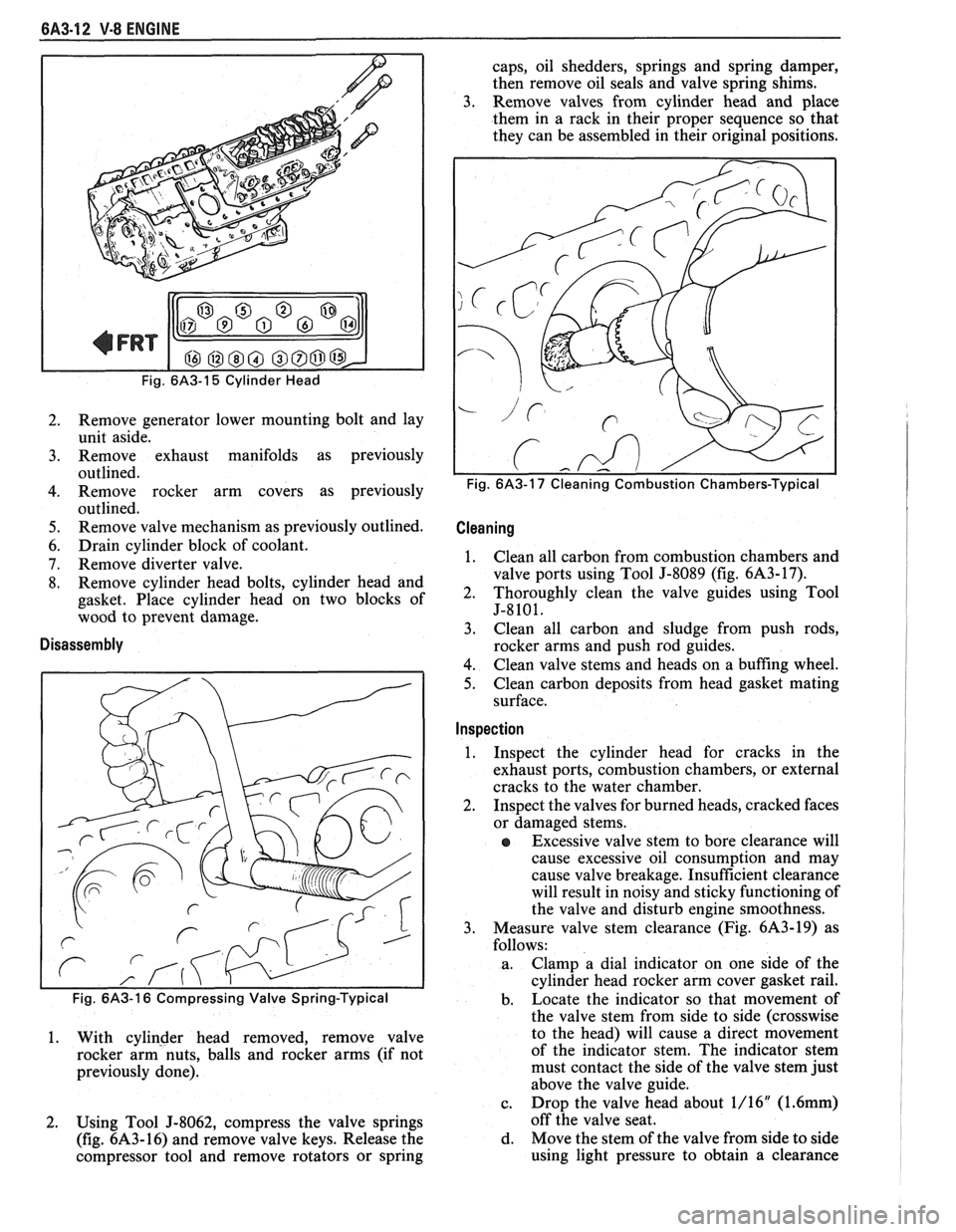
6A3-12 V-8 ENGINE
Fig. 6A3-15 Cylinder Head
2. Remove generator lower mounting bolt and lay
unit aside.
3. Remove exhaust manifolds as previously
outlined.
4. Remove rocker arm covers as previously
outlined.
5. Remove valve mechanism as previously outlined.
6. Drain cylinder block of coolant.
7. Remove diverter valve.
8. Remove cylinder head bolts, cylinder head and
gasket. Place cylinder head on two blocks of
wood to prevent damage.
Disassembly
1. With cylinder head removed, remove valve
rocker arm nuts, balls and rocker arms (if not
previously done).
2. Using Tool
5-8062, compress the valve springs
(fig.
6A3-16) and remove valve keys. Release the
compressor tool and remove rotators or spring caps, oil shedders,
springs and spring damper,
then remove oil seals and valve spring shims.
3. Remove valves from cylinder head and place
them in a rack in their proper sequence so that
they can be assembled in their original positions.
Cleaning I
1. Clean all carbon from combustion chambers and
valve ports using Tool J-8089 (fig.
6A3-17).
2. Thoroughly clean the valve guides using Tool
5-8101.
3. Clean
all carbon and sludge from push rods,
rocker arms and push rod guides.
4. Clean valve stems and heads on a buffing wheel.
5. Clean carbon deposits from head gasket mating
surface.
Inspection I
1. Inspect
the cylinder head for cracks in the
exhaust ports, combustion chambers, or external
cracks to the water chamber.
2. Inspect the valves for burned heads, cracked faces
or damaged stems.
e Excessive valve stem to bore clearance will
cause excessive oil consumption and may
cause valve breakage. Insufficient clearance
will result in noisy and sticky functioning of
the valve and disturb engine smoothness.
3. Measure valve stem clearance (Fig. 6A3-19) as
follows:
a. Clamp a dial indicator
on one side of the
cylinder head rocker arm cover gasket rail.
b. Locate
the indicator so that movement of
the valve stem from side to side (crosswise
to the head) will cause a direct movement
of the indicator stem. The indicator stem
must contact the side of the valve stem just
above the valve guide.
c. Drop
the valve head about 1/16"
(1.6mm)
off the valve seat.
d. Move the stem of the valve from side to side
using light pressure to obtain a clearance
Page 395 of 1825
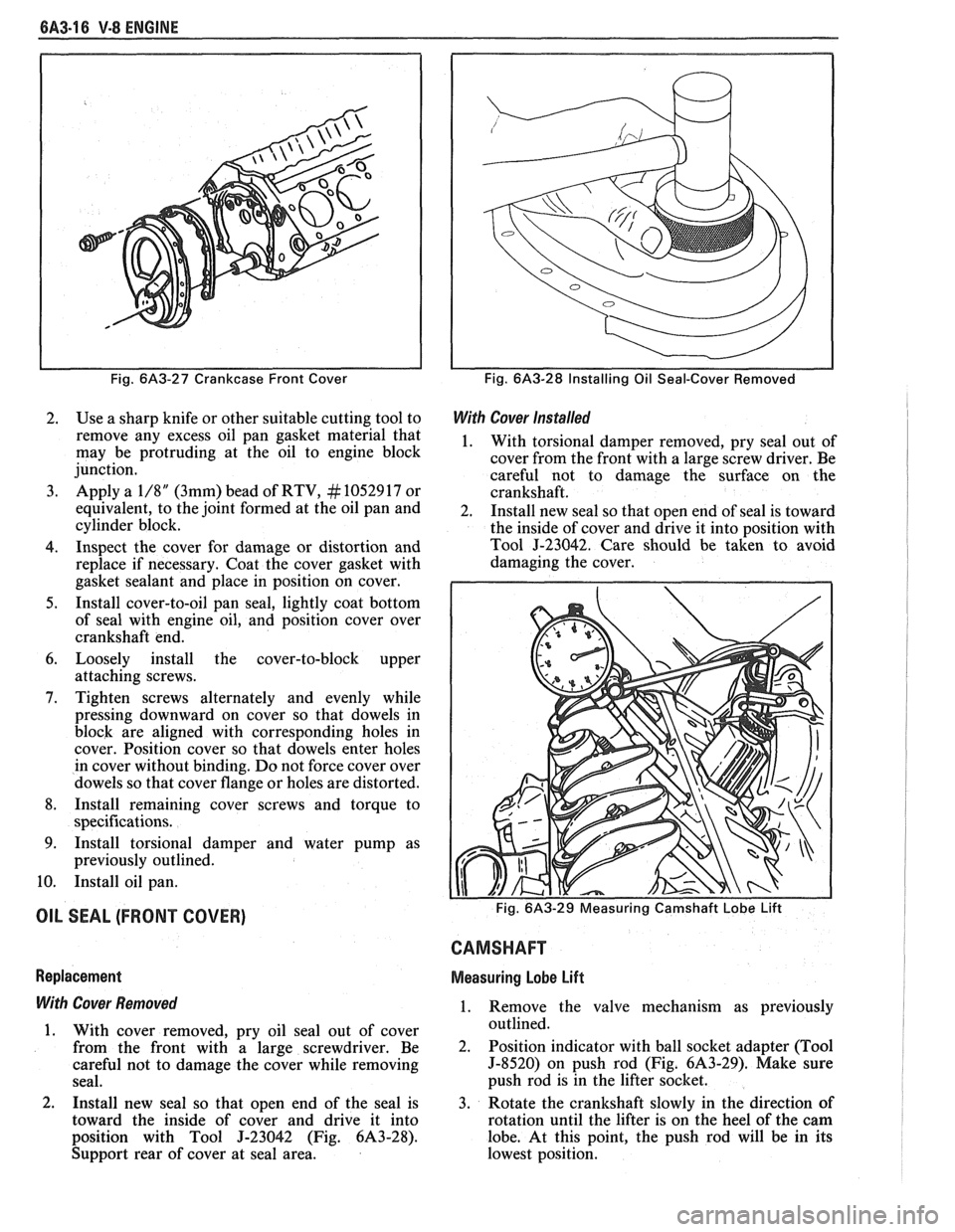
6A3-16 V-8 ENGINE
Fig. 6A3-27 Crankcase Front Cover
2. Use a sharp knife or other suitable cutting tool to
remove any excess oil pan gasket material that
may be protruding at the oil to engine block
junction.
3. Apply a 1/8" (3mm) bead of RTV, # 10529 17 or
equivalent, to the joint formed at the oil pan and
cylinder block.
4. Inspect the cover for damage or distortion and
replace if necessary. Coat the cover gasket with
gasket sealant and place in position on cover.
5. Install cover-to-oil pan seal, lightly coat bottom
of seal with engine oil, and position cover over
crankshaft end.
6. Loosely install the cover-to-block upper
attaching screws.
7. Tighten screws alternately and evenly while
pressing downward on cover so that dowels in
block are aligned with corresponding holes in
cover. Position cover so that dowels enter holes
in cover without binding.
Do not force cover over
dowels so that cover flange or holes are distorted.
8. Install remaining cover screws and torque to
specifications.
9. Install torsional damper and water pump as
previously outlined.
10. Install oil pan.
OIL SEAL (FRONT COVER)
Replacement
With Cover Removed
1. With cover removed, pry oil seal out of cover
from the front with a large screwdriver. Be
careful not to damage the cover while removing
seal.
2. Install new seal so that open end of the seal is
toward the inside of cover and drive it into
position with Tool
J-23042 (Fig. 6A3-28).
Support rear of cover at seal area.
Fig. 6A3-28 Installing Oil Seal-Cover Removed
With Cover Installed
1. With torsional damper removed, pry seal out of
cover from the front with a large screw driver. Be
careful not to damage the surface on the
crankshaft.
2. Install new seal so that open end of seal is toward
the inside of cover and drive it into position with
Tool
J-23042. Care should be taken to avoid
damaging the cover.
CAMSHAFT
Measuring Lobe Lift
1. Remove the valve mechanism as previously
outlined.
2. Position indicator with ball socket adapter (Tool
5-8520) on push rod (Fig. 6A3-29). Make sure
push rod is in the lifter socket.
3. Rotate the crankshaft slowly in the direction of
rotation until the lifter is on the heel of the cam
lobe. At this point, the push rod will be in its
lowest position.
Page 396 of 1825
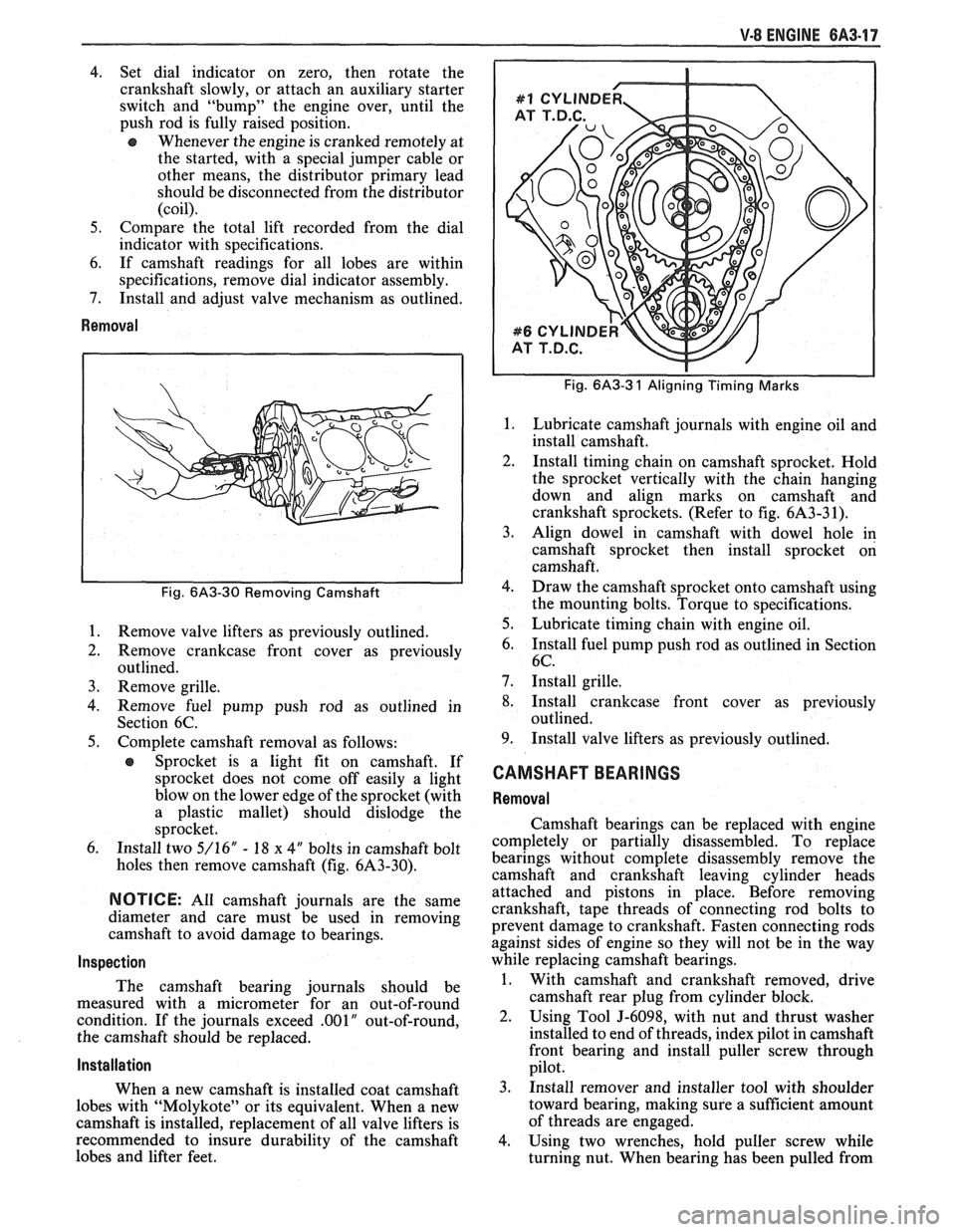
V-8 ENGINE 6A3.17
4. Set dial indicator on zero, then rotate the
crankshaft slowly, or attach an auxiliary starter
switch and "bump" the engine over, until the
push rod is fully raised position.
e Whenever the engine is cranked remotely at
the started, with a special jumper cable or
other means, the distributor primary lead
should be disconnected from the distributor
(coil).
5. Compare the total lift recorded from the dial
indicator with specifications.
6. If camshaft readings for all lobes are within
specifications, remove dial indicator assembly.
7. Install and adjust valve mechanism as outlined.
Removal
Fig. 6A3-30 Removing Camshaft
1.
Remove valve lifters as previously outlined.
2. Remove crankcase front cover as previously
outlined.
3. Remove grille.
4. Remove fuel pump push rod as outlined in
Section 6C.
5. Complete camshaft removal as follows:
e Sprocket is a light fit on camshaft. If
sprocket does not come off easily a light
blow on the lower edge of the sprocket (with
a plastic mallet) should dislodge the
sprocket.
6. Install two 5/16" - 18 x 4" bolts in camshaft bolt
holes then remove camshaft (fig. 6A3-30).
NOTICE: All camshaft journals are the same
diameter and care must be used in removing
camshaft to avoid damage to bearings.
Inspection
The camshaft bearing journals should be
measured with a micrometer for an out-of-round
condition. If the journals exceed
.001" out-of-round,
the camshaft should be replaced.
Installation
When a new camshaft is installed coat camshaft
lobes with "Molykote" or its equivalent. When a new
camshaft is installed, replacement of all valve lifters is
recommended to insure durability of the camshaft
lobes and lifter feet.
Fig. 6A3-3 1 Aligning Timing Marks
Lubricate camshaft journals with engine oil and
install camshaft.
Install timing chain on camshaft sprocket. Hold
the sprocket vertically with the chain hanging
down and align marks on camshaft and
crankshaft sprockets. (Refer to fig. 6A3-3 1).
Align dowel in camshaft with dowel hole in
camshaft sprocket then install sprocket on
camshaft.
Draw the camshaft sprocket onto camshaft using
the mounting bolts. Torque to specifications.
Lubricate timing chain with engine oil.
Install fuel pump push rod as outlined in Section
6C.
Install grille.
Install crankcase front cover as previously
outlined.
Install valve lifters as previously outlined.
CAMSHAFT BEARINGS
Removal
Camshaft bearings can be replaced with engine
completely or partially disassembled. To replace
bearings without complete disassembly remove the
camshaft and crankshaft leaving cylinder heads
attached and pistons in place. Before removing
crankshaft, tape threads of connecting rod bolts to
prevent damage to crankshaft. Fasten connecting rods
against sides of engine so they will not be in the way
while replacing camshaft bearings.
1. With camshaft and crankshaft removed, drive
camshaft rear plug from cylinder block.
2. Using Tool J-6098, with nut and thrust washer
installed to end of threads, index pilot in camshaft
front bearing and install puller screw through
pilot.
3. Install remover and installer tool with shoulder
toward bearing, making sure a sufficient amount
of threads are engaged.
4. Using two wrenches, hold puller screw while
turning nut. When bearing has been pulled from
Page 399 of 1825

6A3-20 V-8 ENGINE
PLASTIC GAGE
Fig. 6A3-35 Gaging Plastic On Crankpin-Typical
4. Measure the crankpin for out-of-round or taper
with a micrometer. If not within specifications
replace or recondition the crankshaft. If within
specifications and a new bearing is to be installed,
measure the maximum diameter of the
crankpin
to determine new bearing size required.
5. If within specifications measure new or used
bearing clearances with Plastigage or its
equivalent.
If a bearing is being fitted to an out-of-round
crankpin, be sure to fit to the maximum diameter
of the crankpin. If the bearing is fitted to the
minimum diameter and the
crankpin is
out-of-round .OO 1
" interference between the
bearing and
crankpin will result in rapid bearing
failure.
a. Place a piece of gaging plastic, the length of
the bearing (parallel to the crankshaft), on
the
crankpin or bearing surface (fig.
6A3-35). Plastic gage should be positioned
in the middle of the bearing shell. (Bearings
are eccentric and false readings could occur
if placed elsewhere).
b. Install the bearing in the connecting rod and
cap.
c. Install the bearing cap and evenly torque
nuts to specifications.
NOTICE: Do not turn the crankshaft with the
gaging plastic installed.
d. Remove the bearing cap and using the scale
on the gaging plastic envelope, measure the
gaging plastic width at the widest point (fig.
6A3-36).
6. If the clearance exceeds specifications, select a
new, correct size, bearing and remeasure the
clearance.
Be sure to check what size bearing is being
removed in order to determine proper
replacement size bearing. If clearance cannot be
brought to within specifications, the
crankpin
Fig. 6A3-36 Measuring Gaging Plastic-Typical
will have to be ground undersize. If the crankpin
is already at maximum undersize, replace
crankshaft.
7. Coat the bearing surface with oil, install the rod
cap and torque nuts to specifications.
8. When all connecting rod bearings have been
installed tap each rod lightly (parallel to the
crankpin) to make sure they have clearance.
9. Measure all connecting rod side clearances (see
specifications) between connecting rod caps (fig.
6A3-37).
..WS1'TQ.014" 1
s
/
SIDE CLEARANCE
Fig.
6A3-37 Measuring Connecting Rod Side
Clearance-Typical
MAIN BEARINGS (FIG. 8A3-38)
Main bearings are of the precision insert type and
do not utilize shims for adjustment. If clearances are
found to be excessive, a new bearing, both upper and
lower halves, will be required. Service bearings are
available in standard size and
,001 ", .002", .009", .01OV
and .020" undersize.
Selective fitting of both rod and main bearing
inserts is necessary in production in order to obtain
close tolerances. For this reason you may find one half
Page 403 of 1825
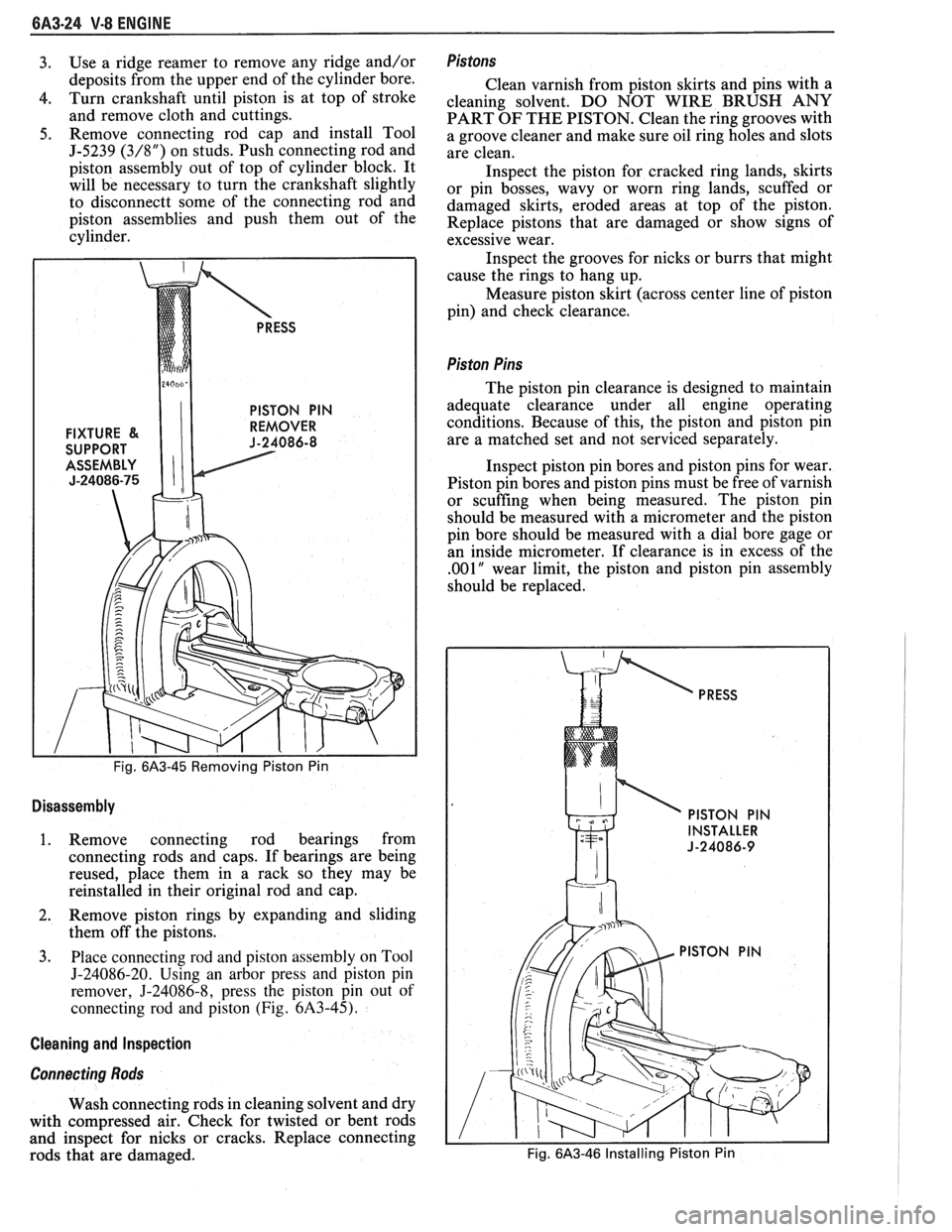
6A3-24 V.8 ENGINE
3. Use a ridge reamer to remove any ridge and/or
deposits from the upper end of the cylinder bore.
4. Turn crankshaft until piston is at top of stroke
and remove cloth and cuttings.
5. Remove connecting rod cap and install Tool
J-5239 (3/8") on studs. Push connecting rod and
piston assembly out of top of cylinder block. It
will be necessary to turn the crankshaft slightly
to disconnectt some of the connecting rod and
piston assemblies and push them out of the
cylinder.
Disassembly
1. Remove connecting rod bearings from
connecting rods and caps. If bearings are being
reused, place them in a rack so they may be
reinstalled in their original rod and cap.
2. Remove piston rings by expanding and sliding
them off the pistons.
3. Piace connecting rod and piston assembly on Tool
J-24086-20. Using an arbor press and piston pin
remover,
5-24086-8, press the piston pin out of
connecting rod and piston (Fig. 6A3-45).
Cleaning and Inspection
Connecting Rods
Wash connecting rods in cleaning solvent and dry
with compressed air. Check for twisted or bent rods
and inspect for nicks or cracks. Replace connecting
rods that are damaged.
Pis tons
Clean varnish from piston skirts and pins with a
cleaning solvent. DO NOT WIRE BRUSH ANY
PART OF THE PISTON. Clean the ring grooves with
a groove cleaner and make sure oil ring holes and slots
are clean.
Inspect the piston for cracked ring lands, skirts
or pin bosses, wavy or worn ring lands, scuffed or
damaged skirts, eroded areas at top of the piston.
Replace pistons that are damaged or show signs of
excessive wear.
Inspect the grooves for nicks or burrs that might
cause the rings to hang up.
Measure piston skirt (across center line of piston
pin) and check clearance.
Pis ton Pins
The piston pin clearance is designed to maintain
adequate clearance under all engine operating
conditions. Because of this, the piston and piston pin
are a matched set and not serviced separately.
Inspect piston pin bores and piston pins for wear.
Piston pin bores and piston pins must be free of varnish
or scuffing when being measured. The piston pin
should be measured with a micrometer and the piston
pin bore should be measured with a dial bore gage or
an inside micrometer. If clearance is in excess of the
,001" wear limit, the piston and piston pin assembly
should be replaced.
PRESS
PISTON PIN
INSTALLER
J-24086-9
Fig. 6A3-46 Installing Piston Pin
Page 404 of 1825

V-8 ENGINE 6A3-25
Assembly
1. Lubricate piston pin holes in piston and
connecting rod to facilitate installation of pin.
2. Place connecting rod in piston and hold in place
with piston pin guide and piston pin. Place
assembly on fixture and support assembly.
3. Using piston pin installer, 5-24086-9, press the
piston pin into the piston and connecting rod (Fig.
6A3-46).
NOTICE: After installer hub bottoms on support
assembly, do not exceed
5000 psi pressure, as this
could cause structural damage to the tool.
4. Remove piston
and connecting rod assembly
from tool and check piston for freedom of
movement on piston pin.
Piston Rings
All compression rings are marked on the upper
side of the ring. When installing compression rings,
make sure the MARKED SIDE IS TOWARD THE
TOP
OF THE PISTON. The top ring is chrome faced,
or treated with molybdenum for maximum life. The
second compression ring is a tapered face acting as
both a compression and oil control ring.
The oil control rings are of three piece type,
consisting of two segments (rails) and a spacer.
Fig. 6A3-47 Measuring Ring Gap
1. Select rings comparable in size to the piston being
used.
2. Slip the compression ring in the cylinder bore;
then press the ring down into the cylinder bore
about
1/4" (6.5mm) (above ring travel). Be sure
ring is square with cylinder wall.
3. Measure the space or gap between the ends of the
ring with a feeler gage (Fig.
6A3-47).
4. If the gap between the ends of the ring is below
specifications, remove the ring and try another
for fit.
5. Fit each compression ring to the cylinder in
which it is going to be used.
6. If the pistons have not been cleaned and inspected
as previously outlined, do so.
Fig. 6A3-48 Checking Ring in Groove
7. Slip the outer surface of the top and second
compression ring into the respective piston ring
groove and roll the ring entirely around the groove
(Fig.
6A3-48) to make sure that the ring is free.
If binding occurs at any point, the cause should
be determined. If binding is caused by ring groove,
correct by dressing with a fine cut file. If
the
binding is caused by a distorted ring, check a new
ring.
8. Install piston rings as follows:
a. Install oil ring spacer in groove and insert
anti-rotation tang (where applicable) in
drilled hole.
b. Hold spacer ends butted and install lower
steel oil ring rail with gap properly located.
c. Install
upper steel oil ring rail with gap
properly located.
d. Flex the oil ring assembly to make sure ring
is free. If binding occurs at any point the
cause should be determined. If binding is
caused by ring groove, correct by dressing
groove with a fine cut file. If binding is
caused by a distorted ring, check a new ring.
e. Install second compression ring
(manufacturer mark up) with gaps properly
located.
f. Install top compression ring (manufacturer
mark up) with gap properly located.
9. Proper clearance of the piston ring in its piston
ring groove is very important to provide proper
ring action and reduce wear. Therefore, when
fitting new rings, the clearances between the
surfaces of the ring and groove should be measured
(Fig.
6A3-49). (See Specifications).
Installation
Cylinder bores must be clean before piston
installation. This may be accomplished with a hot
water and detergent wash or with a light honing as
necessary. After cleaning, the bores should be swabbed
several times with light engine oil and a clean dry cloth.
1. Lubricate connecting rod bearings and install in
rods and rod caps.
Page 405 of 1825
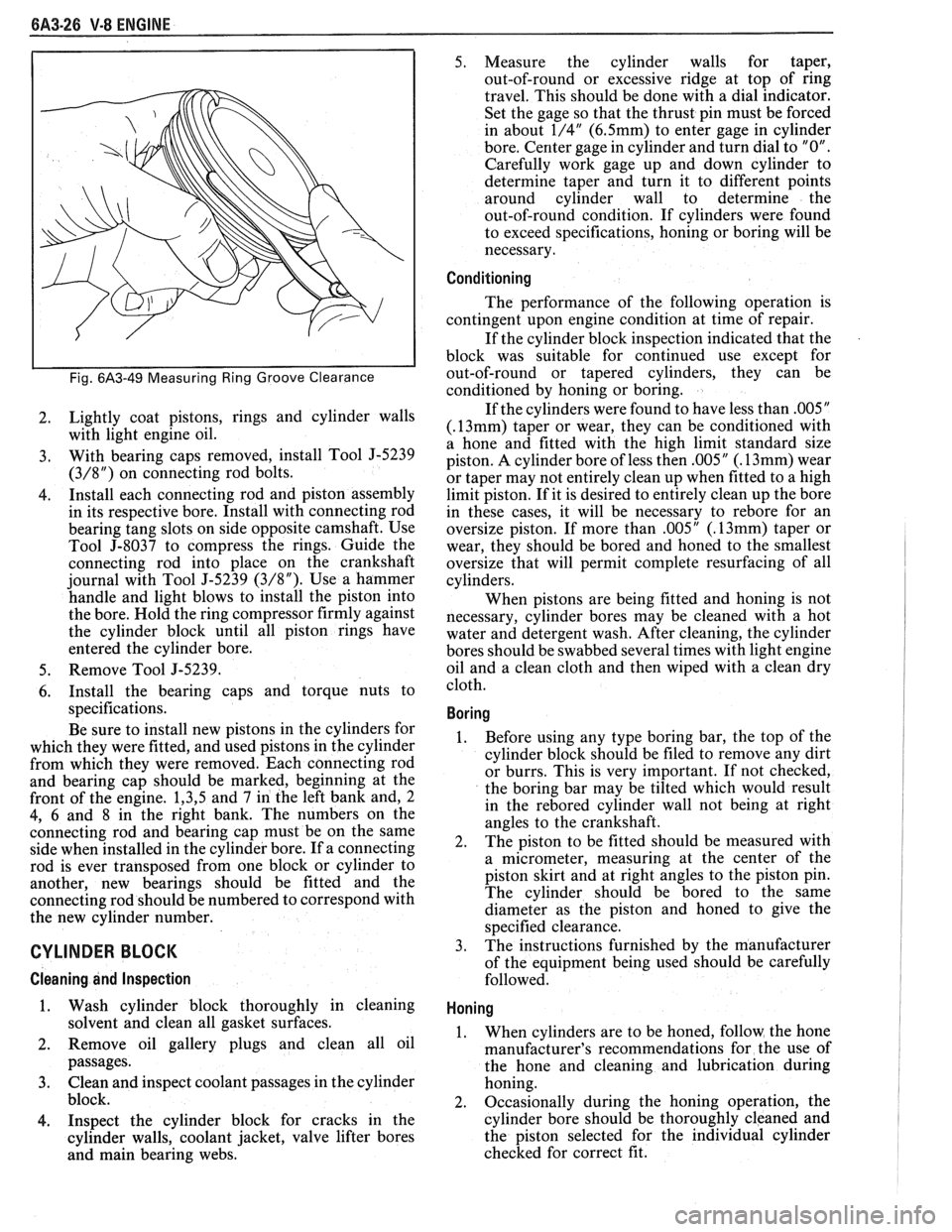
6A3-26 V-8 ENGINE
Fig. 6A3-49 Measuring Ring Groove Clearance
2. Lightly coat pistons, rings
and cylinder walls
with light engine oil.
3. With bearing caps removed, install Tool J-5239
(3/8") on connecting rod bolts.
4. Install
each connecting rod and piston assembly
in its respective bore. Install with connecting rod
bearing tang slots on side opposite camshaft. Use
Tool
5-8037 to compress the rings. Guide the
connecting rod into place on the crankshaft
journal with Tool
5-5239 (3/8"). Use a hammer
handle and light blows to install the piston into
the bore. Hold the ring compressor firmly against
the cylinder block until all piston rings have
entered the cylinder bore.
5. Remove Tool J-5239.
6. Install the bearing caps and torque nuts to
specifications.
Be sure to install new pistons in the cylinders for
which they were fitted, and used pistons in the cylinder
from which they were removed. Each connecting rod
and bearing cap should be marked, beginning at the
front of the engine.
1,3,5 and 7 in the left bank and, 2
4, 6 and 8 in the right bank. The numbers on the
connecting rod and bearing cap must be on the same
side when installed in the cylinder bore. If a connecting
rod is ever transposed from one block or cylinder to
another, new bearings should be fitted and the
connecting rod should be numbered to correspond with
the new cylinder number.
CYLINDER BLOCK
Cleaning and Inspection
1. Wash cylinder block thoroughly in cleaning
solvent and clean all gasket surfaces.
2. Remove oil gallery plugs and clean all oil
passages.
3. Clean and inspect coolant passages in the cylinder
block.
4. Inspect the cylinder block for cracks in the
cylinder walls, coolant jacket, valve lifter bores
and main bearing webs. 5.
Measure the cylinder walls for taper,
out-of-round or excessive ridge at top of ring
travel. This should be done with a dial indicator.
Set the gage so that the thrust pin must be forced
in about
1/4" (6.5mm) to enter gage in cylinder
bore. Center gage in cylinder and turn dial to
"0".
Carefully work gage up and down cylinder to
determine taper and turn it to different points
around cylinder wall to determine the
out-of-round condition. If cylinders were found
to exceed specifications, honing or boring will be
necessary.
Conditioning
The performance of the following operation is
contingent upon engine condition at time of repair.
If the cylinder block inspection indicated that the
block was suitable for continued use except for
out-of-round or tapered cylinders, they can be
conditioned by honing or boring.
If the cylinders were found to have less than
.005"
(.13mm) taper or wear, they can be conditioned with
a hone and fitted with the high limit standard size
piston. A cylinder bore of less then
.005" (. 13mm) wear
or taper may not entirely clean up when fitted to a high
limit piston. If it is desired to entirely clean up the bore
in these cases, it will be necessary to
rebore for an
oversize piston. If more than
.005" (. 13mm) taper or
wear, they should be bored and honed to the smallest
oversize that will permit complete resurfacing of all
cylinders.
When pistons are being fitted and honing is not
necessary, cylinder bores may be cleaned with a hot
water and detergent wash. After cleaning, the cylinder
bores should be swabbed several times with light engine
oil and a clean cloth and then wiped with a clean dry
cloth.
Boring
1. Before using any type boring bar, the top of the
cylinder block should be filed to remove any dirt
or burrs. This is very important. If not checked,
the boring bar may be tilted which would result
in the
rebored cylinder wall not being at right
angles to the crankshaft.
2. The
piston to be fitted should be measured with
a micrometer, measuring at the center of the
piston skirt and at right angles to the piston pin.
The cylinder should be bored to the same
diameter as the piston and honed to give the
specified clearance.
3.
The instructions furnished by the manufacturer
of the equipment being used should be carefully
followed.
Honing
1. When cylinders are to be honed, follow the hone
manufacturer's recommendations for the use of
the hone and cleaning and lubrication during
honing.
2. Occasionally during the honing operation, the
cylinder bore should be thoroughly cleaned and
the piston selected for the individual cylinder
checked for correct fit.
Page 413 of 1825

BB-2 ENGINE COOLING
strength, which protects the radiator by relieving
pressure if it exceeds design limits. The vacuum valve
is held against its seat by a light spring, which permits
opening of the valve to relieve vacuum created in the
system when it cools off and which otherwise might
cause the radiator to collapse.
VACUUM RELIEF PRESSURE RELIEF
Fig. 1 Pressure-Type Radiator Cap
The radiator cap is designed to discourage
inadvertent removal. The finger grips have been
removed so the cap is round in shape. It also must be
pushed downward before it can be removed. A rubber
asbestos gasket is added to the diaphragm spring at the
top of the cap. Embossed on the cap is a caution against
its being opened and arrows indicating the proper
closed position.
Every vehicle has a radiator cap. Also,
J, N and
P Series vehicles with 2.5L engines have a thermostat
housing cap. For these engines, add coolant through
the thermostat housing (with the thermostat and cap
removed).
Recovery Bottle
A "see-through" plastic reservoir, similar to the
familiar windshield washer jar, is connected to the
radiator by a hose. As the car is driven, the coolant is
heated and expands. The portion of the fluid displaced
by this expansion flows from the radiator into the
recovery bottle. When the engine is stopped and the
coolant cools and contracts, the displaced coolant is
drawn back into the radiator by vacuum. Thus, the
radiator is kept filled with coolant to the desired level
at all times, resulting in increased cooling efficiency.
Coolant level should be between "ADD" and
"FULL"
marks on recovery bottle. These marks are
approximately two quarts apart so that a
50/50
mixture can be added (one quart of ethylene glycol
anti-freeze and one quart of water).
FAN
Electric Fan
Fans range in sizes from 290mm (11.6 in) to
422mm (16.9 in) with 4 to 7 blades to aid air flow
through the
radiator/condenser. The fan is driven by
an electric motor which is attached to the radiator
support.
The fan motor is activated by a coolant
temperature switch. If the vehicle is equipped with
Fig. 2 Coolant Recovery Bottle
A/C, a second switch can activate the circuit,
depending upon
A/C compressor head pressure to the
condenser.
CAUTION: If a fan blade is bent or
damaged in any way, no attempt
should be made to repair and reuse the
damaged part.
A bent or damaged fan
assembly should always be replaced
with a new fan assembly. It is
essential that fan assemblies remain
in proper balance and proper balance
cannot be assured once a fan
assembly has been bent or damaged.
A fan assembly that is not in proper
balance could fail and fly apart during
subsequent use, creating an
extremely dangerous condition.
The majority of non-A/C cars use a fan with four
blades which are unevenly spaced and have curled tips
to provide minimum noise.
A fan shroud is used to
prevent recirculation of air around the fan on most
cars.
Thermostatically Controlled Fluid Clutch Fan
A thermostatically controlled fluid clutch fan is
used on some air conditioned vehicles. It operates only
when additional air flow is required to reduce radiator
coolant temperatures. This clutch is of a simple,
functional design. It is made of lightweight metal filled
with silicone oil and is hermetically sealed. The finned
(rear) housing contains a hub assembly (secured to the
housing bearing) which attaches to the engine water
pump. Four bosses with tapped holes in the rear face
provide for attachment of the engine fan. The front
surface of the housing has six deep circular grooves
which index with six matching bosses on the rear face
of a floating clutch. A separator plate and front cover,
with thermostatic coil control, complete the clutch
assembly.
During periods of operation when radiator
discharge air temperature is low, below approximately
66°C (150°F), the clutch limits the fan speed to
800- 1400 rpm. In this position, the clutch is disengaged